If you made some, you’re not alone. People have been declaring such resolutions for centuries as a long-established self-help tradition.
However, according to U.S. News & World Report, the failure rate of these declarations is as high as 80 percent, so an alternate approach is clearly needed. Experts believe that various factors, including resolution expectations, how long resolutions are, and even how you phrase them, can impact your results. The tips below can help you think differently about your New Year’s resolutions, making them more rewarding.

1. Take one good look back.
When you make a New Year’s resolution, it’s an opportunity: you have a clean slate and an entire twelve months to achieve amazing milestones. But this mindset often includes the assumption that your slate has to be wiped clean, i.e., you need a do-over to improve upon—or perhaps forget about—the previous year. You may think you’re beginning the new year on a positive note, but the springboard for it is subconsciously negative.
Instead, reminisce about the prior year with pride. Take one last look at your 2021 accomplishments, especially considering you achieved them during a pandemic, and use that as the momentum to continue doing even more great things in 2022.

2. Make a resolution connection.
Here’s an interesting question: How often do you make New Year’s resolutions with others or ask others to help you achieve them? In truth, these are often solitary journeys—but perhaps they shouldn’t be. A study in Sweden showed that someone having your back might be pivotal to both short-term and long-term resolution success.
3. Remember that words matter.
According to Merriam-Webster.com, to resolve is “to reach a firm decision about” something. Does that sound realistic for a resolution that spans an entire year ahead? For example, you may vow to lose weight in 2022, but without a crystal ball to peek into the future, that may be an unrealistic commitment. You may encounter obstacles, such as a family crisis or unexpected news, that may cause you to forgo your resolution. Such is life, and it doesn’t mean that you’re a failure, but because you broke your “firm decision,” it can feel disappointing.
Instead, swap out the word “resolutions” for something like “goals” or “wish list” for the year, which is a more optimistic, open-ended approach. Similarly, instead of saying “I hope to” or “I aim to,” make use of phrases like “my goals are,” which will reinforce your positivity as the year progresses. And the Swedish study produced another gem to consider: an important word to keep in mind seems to be “adding” rather than “subtracting,” which was a key element to success for participants in the study. So, for example, vowing to eat more fruits and vegetables leads to more success than forgoing chocolate.

4. Think short term as much as long term.
Naturally, most people establish goals for the entire year since they’re making them on or around January 1; however, they won’t magically happen because the calendar has turned over. As mentioned earlier, making your resolutions year-based may not always be the best course of action. In fact, you might find it more effective to plan month by month, week by week, or even daily.
So, for example, if you want to be more humanitarian in 2022, get creative and think of how you can do something different each month to help people. It could be shoveling your neighbors’ driveways and sidewalks when it snows or checking in with relatives once a week in February. If you’ve resolved to declutter your mind and home this year, donate or upcycle one item per week that you don’t need. A daily goal can simply be making a positive comment to yourself or someone else. All these examples illustrate that whittling down your goals into manageable mini goals not only makes it easier to achieve them but also keeps them fresh.
Focusing on SMART goals may help. This acronym-based tool helps keep people laser-focused on their goals by making sure they are specific, measurable, achievable, relevant, and time-based. For example, if you decide that you want to save money in 2022, narrow down your goal. Specify an amount (say, $1,200), how you will measure it ($100 per month) and how you plan to achieve it (home-brewed coffee instead of Starbucks), why it matters (a down payment for a car), and your end date.

5. Write your goals down.
Studies repeatedly show that people remember and follow through on things that they jot down somewhere. This also applies to your 2022 to-do list, which you can keep on a whiteboard, on a piece of paper, or in a notes app on your phone. In addition, journaling has become a popular method of succeeding at goals and can be a creative way to help you achieve yours.
Here’s another tip. If you really want to simplify a goal, challenge yourself to think of and write down a word that you want to define your year as a whole, such as “happiness,” “peace,” or “success,” and then keep a running list of the ways you achieved it, no matter how small or insignificant they may seem. They very well may become an important piece of the puzzle for your year’s overall success.
In January, people often put a lot of thought and energy into what they want to accomplish in the coming year. But your top priority should be rethinking your goals and making them more focused, productive, and attainable. By going about it differently, you’re more likely to look back and smile at your success by year’s end.
We’ve all heard it—social media can have a negative impact on our mental and physical health. And it’s true that anxiety and depression levels, especially in teens, have increased since the introduction of platforms like Instagram and TikTok.
If you’re looking to reevaluate your social media presence without having to delete your accounts, follow this guide to start developing a healthier relationship with your favorite social platforms.

First and foremost, you should be cautious about how often you log on, who you follow, and who you allow to follow you.
Following and followers
Just as you do with your real-world social circle, use your instincts. Avoid following people you don’t know or don’t care to involve in your life. Ask yourself, “If this person introduced themselves to me in person, what would I say to them, and how would the interaction go?” It’s OK to say no to people’s requests.
Logging on
Don’t burn yourself out by spending too much time on social media. According to a 2018 study published in the Journal of Social and Clinical Psychology, limiting your social media use to around thirty minutes a day can lead to improved health outcomes because of several factors, such as having less exposure to harmful blue light from your phone or laptop and avoiding information overload. Using social media can be beneficial and fun, but getting off your phone and going outside is always the best option to improve your well-being.

At the end of each day, reflect for a few minutes on how your social media experience was.
Potential negatives
Being honest can go a long way toward helping you develop the healthiest relationship possible with social media. Ask yourself the following questions:
Positives
Not everything has to be negative when you reflect, so consider the positives of that day too. Here are a few points to consider:

Humans are social beings. There is no avoiding interaction with others, but as the COVID-19 pandemic has highlighted, the internet is evolving into a supplement when in-person interactions aren’t possible. Tailor your social media experience to what you want out of it. By doing so, you can take hold of the “algorithm” of advertisers to see the content you want and only interact with people you want to interact with. Below are the types of social media experiences you might consider trying for the most benefit.
Personal
This is the most common type of social media presence. Personal profiles are typically private and used to interact with friends, family, and the coworkers you let into your in-person social circles. For people with more personal profiles, social media is merely a tool to see updates from others and post content about their lives.
Professional
As the social media world has evolved, professional profiles have gained popularity. Professional profiles use social media platforms as networking tools, and your profile is typically public for this reason. Your feed will have career-building content and updates from professionals you interact with or look up to. If you own a small business, consider having a professional profile for free marketing!
Creative
Posting content is already an inherently creative activity. But if you have a knack for a hobby, such as art, woodworking, or music, you can use social media to spread your love for your craft. Profiles can vary between public or private, and your feed is typically a mix of loved ones and other people interested in the same creative outlet as you. Think of it as a coffee shop open-mic night—there are people you do and do not know in the audience appreciating your work, but you know that those you don’t know are potential friends.
Informative
Educational content and news are abundant on social media platforms. You can learn about almost any topic and stay updated on local, national, and global news by remaining social and asking questions to learn from other people. Inquisitive people tend to bond easily, so you can use your social media account to make friends near and far that you may not encounter in person.

Limiting time, as mentioned above, is a key ingredient in the recipe for social media success. If you find that the temptation to go on social media is a hard habit to break, you can implement one or more of the strategies below.
App timers
Most smartphones have a function that allows you to use a particular app for a set amount of time per day. Once you use that time up, the app locks, and you cannot access it until the following day. However, you can go into your settings and manually unlock it if you need to access something.
Screen time
Here’s a reality check: you’re probably spending more time on your phone than you realize. Go into your screen time under Settings, and look at the breakdown of how much time you typically spend on social media. A lot of people cringe at the wasted hours spent on Instagram and other platforms.
Accountability
Ask your loved ones to hold you accountable. If a friend or family member notices you are online, have them ask if you’ve taken a break from social media today. Additionally, you can ask a member of your household to point out when they see you scrolling for a while.
Social media has its positives and negatives—but you’ll have a much better experience if you use it wisely. By practicing these tips, you can find where social media fits into your life in a healthy way instead of fitting your life around it. Your mental health will thank you!
Winter cooking is all about warmth and comfort, and dishes like soups, stews, and curries are the perfect way to warm up and fill up this time of year. These recipes from 5-Ingredient Vegan Cooking by Kate Friedman are full of delectable, filling ingredients that pack a nutritious punch.
Chickpeas are an amazing, protein-packed meat alternative, and this simple stew makes them the star of the show.
This slightly spicy Thai-inspired dish is full of bold flavors and colors and is guaranteed to keep you warm on those chilly January nights.
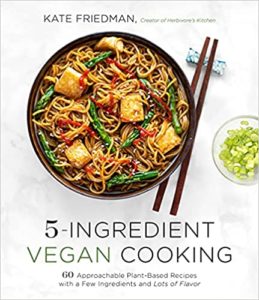
Reprinted with permission from 5-Ingredient Vegan Cooking by Kate Friedman, Page Street Publishing Co. 2021. Photo credit: Kate Friedman
recipe by kate friedman
photos by kate friedman
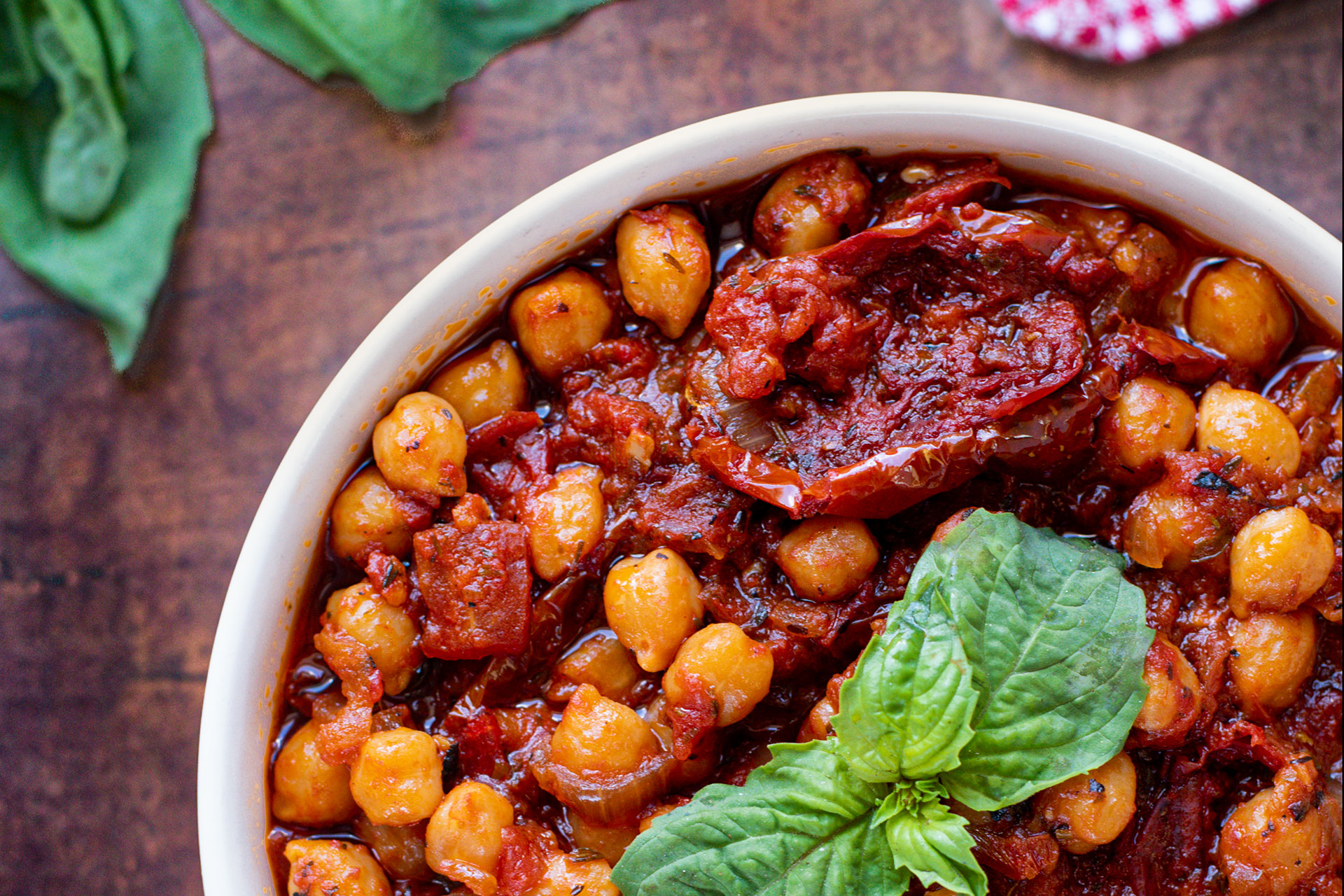
This dinner ranks up there among my favorites. Not only is it really rich and savory, I almost always have all of the ingredients in my kitchen, making it an easy answer to the late-afternoon question: “What’s for dinner?” This recipe uses one of my favorite kitchen hacks—sautéing tomato paste for extra flavor. You’ll see this again and again throughout my recipes, and for good reason. Sautéing tomato paste gives it an amazing richness. I’ve made this recipe with both dried and canned chickpeas. For the sake of ease, I recommend using canned chickpeas.
Serves 2
RECIPE NOTES:
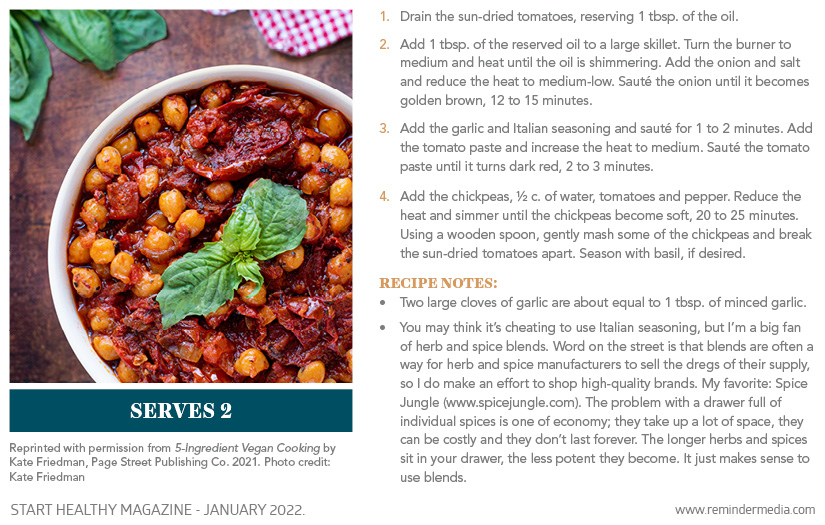
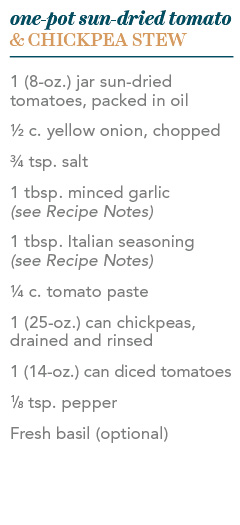
recipe by kate friedman
photos by kate friedman

This simple Thai-inspired dish is perfect for cozying up on a chilly evening. It’s both spicy and sweet—products of the red curry paste and creamy coconut milk. Red curry is moderately spicy and slightly sweet, getting its flavor from red chilies. Other ingredients in red curry paste include garlic, galangal (Thai ginger), coriander, cumin, black pepper, kaffir lime leaves, lemongrass and turmeric. Red curry paste is a complicated ingredient to make yourself, so I often opt for the store-bought version. Just pay attention when purchasing, as curry paste traditionally includes shrimp paste. There are vegan versions of red curry paste available though. I recommend Thai Kitchen’s Red Curry Paste.
Serves 2
RECIPE NOTES:

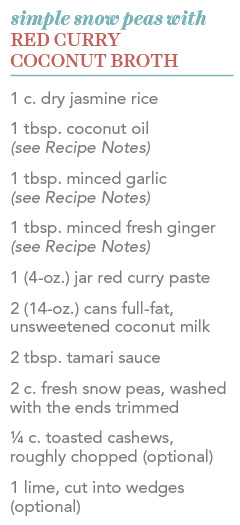
With a new year comes refreshed motivation, which may include a new eating regimen. However, it can be overwhelming to know where to start. From keto to vegan, there are diet options that offer a host of benefits for your body. However, these types of diets don’t always deliver long-term results. While you might have some initial success, researchers at UCLA found that some fad diets do not lead to sustained weight loss or provide health benefits.
If you’re looking to make healthy changes to your eating habits, try incorporating more whole foods into your meals. This approach allows you to eat an array of tasty foods by making simple changes.
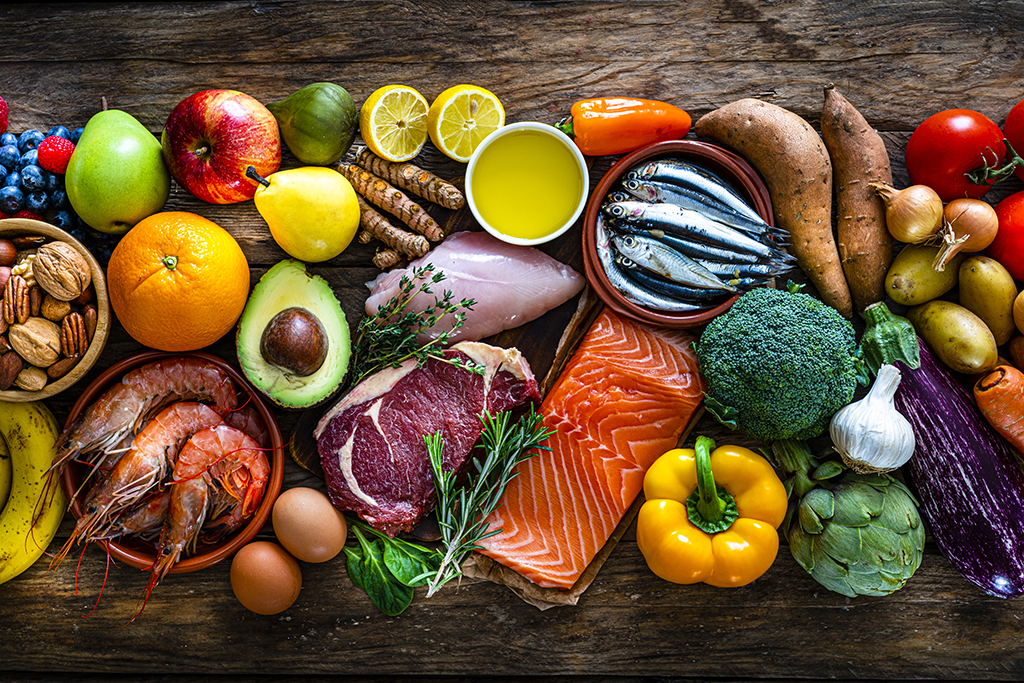
Whole foods, sometimes called unprocessed foods, are not manipulated from their original form before reaching your plate. These foods include plants, such as fruits, nuts, vegetables, and seeds, along with animal products like meat, eggs, and dairy. Two other categories of foods you’ll find are minimally processed foods and heavily processed foods, which usually provide fewer nutritional benefits than the whole foods mentioned above.
Minimally processed foods
These foods start as whole foods before being altered through cutting, freezing, cooking, canning, fermenting, packaging, or a combination of these processes. They have minimal or no added ingredients, making them close or equal to whole foods. A couple of examples of minimally processed foods are bagged salad mixes and frozen fruits.
Heavily processed foods
These foods have added ingredients, such as salt, sugar, preservatives, thickeners, dyes, or oils, that alter the nutritional content by eliminating vitamins, minerals, and fiber. Examples of heavily processed foods include frozen meals and deli meats.
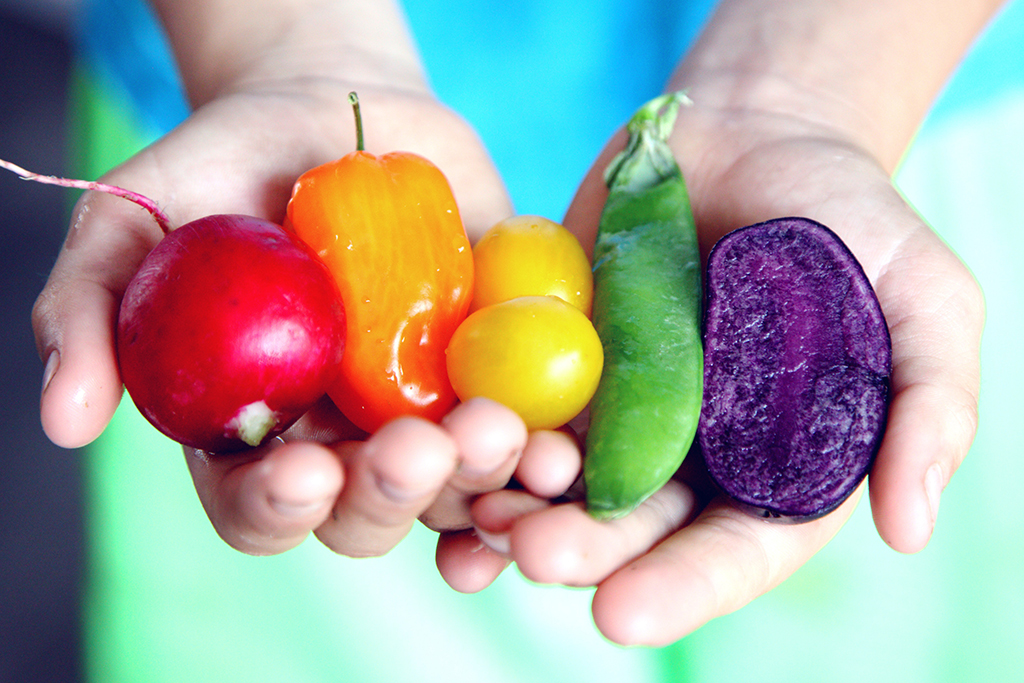
There is a lot of truth to the saying “You are what you eat.” By adding more whole and minimally processed foods to your diet, you could reap several health benefits.
These findings are significant because the additives in highly processed foods can adversely affect your health. A National Institutes of Health study found that individuals who had a mostly processed diet ate faster, consumed 500 hundred more calories per day, and gained more weight than those consuming an unprocessed diet.
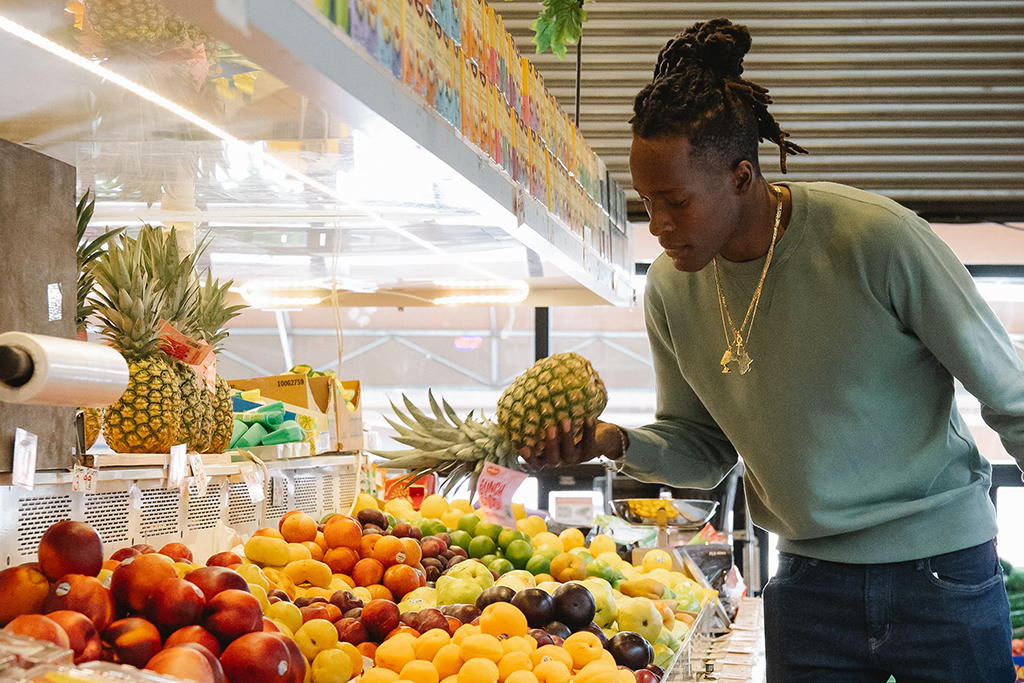
One of the best things about incorporating more whole foods into your diet is it doesn’t have to be all or nothing, and the focus should be on general healthy-eating habits. Try to eat a balance of protein, carbohydrates, and fats in each of your meals.
While some people will take a plant-based approach to a whole foods diet, you can still eat animal products and receive the same benefits. Choose meat raised without hormones or antibiotics, and replace heavily processed dairy with items like plain Greek yogurt or feta cheese.
Start your transition into eating more whole foods with small changes, such as replacing:
Remember, you don’t have to adopt a strict whole foods diet overnight. While heavily processed foods aren’t the healthiest option, you should establish healthy boundaries and focus on eating a diet comprised primarily of whole or minimally processed foods. Some good ways to actively eat more whole foods include cooking more meals at home, making smarter decisions when eating out, such as choosing baked or grilled options over deep-fried ones, and packing your lunch for work or school instead of buying takeout.

Going shopping is when your healthy-eating plans can fall through as temptation leads you to buy some of your favorite snacks. However, by following some of the simple suggestions below when purchasing food, you’ll be on your way to eating more unprocessed foods:
Remember to check the labels of all products so you know what they contain and avoid unhealthy additions, such as fat, sugar, and salt. A good rule of thumb is to choose food with a shorter ingredient list that contains words you recognize.
By adding more whole foods to your diet, you may feel a whole lot better about healthy eating.





